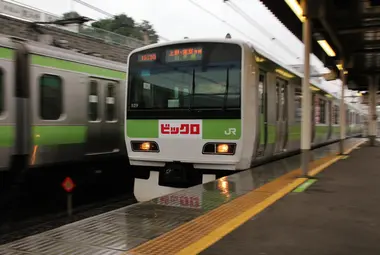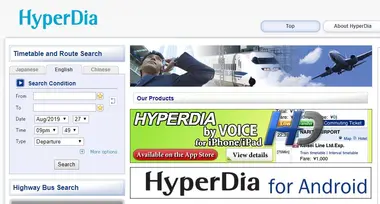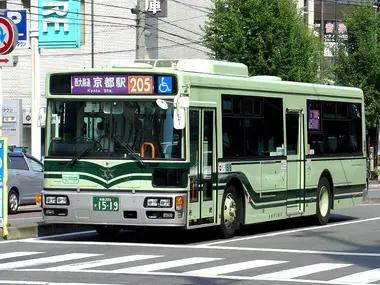Hyperdia: a complete guide to the Japan route planner and its alternatives
- Published on : 01/04/2022
- by : G.L./Ph.L
- Youtube

The new GSE 70 000 train
Wikipedia
Hyperdia has long been the benchmark tool for planning train journeys in Japan, enabling travelers from all over the world to easily navigate Japan's complex rail network. Launched in 2008 by Japan Railways, this revolutionary application was designed to simulate precise routes throughout the archipelago. It provided detailed information on timetables, connections and fares, becoming an indispensable tool for tourists and Japanese alike. However, since 2022, the application has undergone major changes that have considerably altered its usefulness and relevance to travelers.
What is Hyperdia and how has it evolved?
Hyperdia was much more than a simple route planner. The application brought together information on every train and subway line running throughout Japan, making it easy to determine the fastest or most economical route between two points. The service particularly excelled in its ability to provide precise train timetables at all times, the exact time between each connection, and the detailed price of each route.
Initially conceived as a database, the application has been gradually enriched over the years. Its ease of use and accuracy have contributed to its immense popularity, with foreign travellers and Japanese alike. In particular, it made it possible to quickly find complex routes such as Nagasaki-Kagoshima via Fukuoka, or the cheapest train to Sendai from Nikko.
Over time, Hyperdia expanded its services to include a long-distance bus database, called "Highway Bus Search". This function simulated a bus journey between two major Japanese cities, indicating the various stops, fares and even details of seat configuration (USB sockets, sleeper mode, etc.).
The mobile version of the app offered additional features, such as the "Hyperdia by voice" voice mode, which enabled users to search for journeys simply by pronouncing station names - a considerable asset in a country where station names can be difficult for foreigners to memorize.
Hyperdia's major changes since 2022 and their impact on travel planning
March 31, 2022 marked a decisive turning point in Hyperdia's history, with the discontinuation of the route-finding service based on precise train timetables. This major change was announced via a message on the website, indicating that the route-finding service using train timetables would be permanently discontinued, while specifying that the route-finding function based on average journey times would remain available.
This change has considerably reduced the usefulness of the application for travellers. Without access to precise departure and arrival times, it became difficult to plan a detailed itinerary. The app now only shows the different fares available for different types of train or bus, but does not specify what time to arrive at the platform - crucial information in a country where punctuality is a must.
Another important change was the inability to exclude Nozomi/Mizuho trains from search results. This function was particularly useful for Japan Rail Pass holders, as these fast trains are not included in the pass (except from October 2023, at extra cost). Without this filtering option, JR Pass users must now manually check which trains they can take.
The exact reasons for these changes have never been clearly communicated. Some point to data licensing issues, others to the impact of the COVID-19 pandemic on the company's finances. Whatever the case, these changes have considerably diminished Hyperdia's appeal for travel planning in Japan.
Current Hyperdia features: what's still available to travellers
Despite these significant changes, Hyperdia continues to offer certain features that may prove useful to travelers. The service still provides information on average journey times between different destinations, giving a general idea of how long it takes to get from one point to another.
Users can also consult approximate fares for different routes, including both the price of the standard ticket and that of any seat reservations. This information is invaluable for estimating a trip's transport budget, or determining whether a Japan Rail Pass is cost-effective for a given itinerary.
Hyperdia's interface still allows you to specify the type of transport required (local, express, Shinkansen, metro, etc.), although the results provided are less detailed than before. The ability to specify the maximum number of connections accepted is also retained, helping to find more direct routes.
Although the app no longer displays specific timetables for each station, it still provides the names of the services to be taken, enabling travellers to search for this information on other platforms or directly with the rail companies. In addition, the "Map" function remains available, offering an overview of the surroundings of selected stations.
How to use Hyperdia effectively despite its limitations
To get the most out of Hyperdia in its current version, we recommend using it primarily as an estimation tool, rather than for precise planning. The application is still useful for comparing different transport options and getting a general idea of costs and journey times.
The first step is to fill in the "from" and "to" fields in the search tab. The application automatically suggests station names based on the letters entered, making it easier to select departure and arrival points. Next, you need to specify the date and approximate time of travel.
To refine your search, you can use the additional options available via the "More options" menu. Here, you can specify the maximum number of connections ("route outputs") and select the types of transport you wish to use. Please note, however, that the option to exclude Nozomi/Mizuho trains is no longer available.
Once the results are displayed, concentrate on the duration and cost information rather than the precise timetable. This will help you decide which transport option is best suited to your needs. If you're traveling with a Japan Rail Pass, check manually whether the suggested services are covered by your pass.
To fill in missing information, we recommend using Hyperdia in conjunction with other resources. For example, once you've identified the type of train you want to take via Hyperdia, you can consult the official Japan Railways website or another application to obtain precise timetables.
Alternatives to Hyperdia for planning your trip to Japan
Given Hyperdia's current limitations, a number of alternatives have been developed to help travelers plan their trips to Japan. One of the most popular is Jorudan (Japan Transit Planner), available in web and mobile application versions. This service is particularly appreciated for its ease of use and the accuracy of its information.
Unlike Hyperdia, Jorudan always displays complete train timetables, as well as platform and station details. The app also features a specific filter for the Japan Rail Pass, allowing only trains covered by the pass to be displayed - a particularly valuable feature for tourists. See our article on the Jorudan app for more details.
Japan Travel by Navitime is another quality alternative, offering many of the same features as Jorudan. This application stands out for its user-friendly interface and availability in French, although the translation is sometimes approximate. It also lets you filter results according to Japan Rail Pass and offers access to timetables for each station - a feature reminiscent of the old Hyperdia.
For simpler journeys, Google Maps has improved considerably in recent years and is now a viable option for route planning in Japan. Its map-centric interface makes it easy to visualize the various options, and the search system is particularly effective for finding routes combining train, bus and walking. However, Google Maps does not allow you to filter routes according to JR Pass. Other applications such as the Japan Official Travel App can also be useful. Developed by the Japan Tourism Board, this app offers not only transport information, but also tourist tips, subway maps and emergency numbers. However, it's important to note that this app has been discontinued since the end of 2023.
Application comparison: Google Maps, Japan Travel by Navitime and Japan Official Travel App
Google Maps excels in its versatility and ease of use. The application offers an intuitive interface and excellent cartography for clear visualization of routes. It is particularly effective for complex itineraries combining different modes of transport (train, metro, bus, walking) and offers real-time GPS navigation functions, provided you have an internet connection.
The Google Maps search system is very comprehensive, and often manages to find excellent routes using local bus routes that are sometimes difficult to locate on other applications. This makes it a particularly useful tool for those planning to travel to areas with less train service, such as Shikoku, Hokkaido or Kyushu.
However, Google Maps has one major limitation: the impossibility of filtering journeys according to the Japan Rail Pass. For travelers using this pass, it can be difficult to quickly identify which lines are covered and which require additional payment.
Japan Travel by Navitime stands out for its specialization in travel within Japan. The application lets you filter results according to the Japan Rail Pass you own, automatically displaying "free" journeys covered by the pass. All types of pass are taken into account, including regional passes and metro passes for major cities.
Another major Navitime advantage is the ability to access timetables for each station, enabling you to see all train departures for a given destination over the course of a week. This feature is particularly useful for quickly finding out the extent of service, including the time of the first and last train of the day.
The application also features a "travel" function that lets you bookmark places, hotels or restaurants for easy retrieval. It is available in French, although the translation is sometimes approximate. However, since 2023, some advanced features require a premium subscription (around €15 per month).
Japan Official Travel App, developed by Japan's National Tourist Board, was a comprehensive application combining transport information and tourist tips. It allowed results to be filtered according to Japan Rail Pass and offered digital versions of all the subway maps of Japan's major cities.
The application also contained practical information such as emergency telephone numbers and a list of foreign embassies in Japan. However, it's important to note that Japan Official Travel App has been discontinued since the end of 2023, reducing options for travelers.
How to choose the best app for your type of travel and JR Pass use
Choosing the ideal app depends largely on your itinerary and specific needs. If you're planning a classic tour between Japan's major cities (Tokyo, Kyoto, Osaka, Hiroshima) and mainly use the rail network, Japan Travel by Navitime or Jorudan will probably be your best options thanks to their JR Pass filter.
For those who use a Japan Rail Pass, we strongly recommend that you choose applications offering a specific filter function. This will enable you to easily identify the trains covered by your pass and avoid unpleasant surprises. Jorudan is particularly effective in this respect, as its free version includes this essential feature.
If you're planning to get off the beaten track and explore less touristy areas, Google Maps might prove more useful thanks to its exhaustive coverage of local transport, including rural buses. In this case, it may be a good idea to combine Google Maps with a specialized application like Navitime to benefit from the advantages of both.
For travelers planning to take long-distancebuses on a regular basis , Jorudan generally offers more comprehensive information on these services. On the other hand, for urban subway travel, all the applications mentioned provide reliable information.
Don't hesitate to use several applications to complement your trip. For example, you could consult Navitime or Jorudan to plan your JR Pass train journeys, then use Google Maps for real-time navigation once you're there. This combined approach will enable you to benefit from the strengths of each service.
In short, although no current application can quite replace the old Hyperdia in all its functionalities, the alternatives available offer effective solutions for planning your travels in Japan. The key is to choose the tool that best suits your travel style and specific needs, so you can take full advantage of the remarkable efficiency of the Japanese transport network. Don't forget to buy the Japan Rail Pass for free travel on all JR lines for the duration of your stay in Japan.













